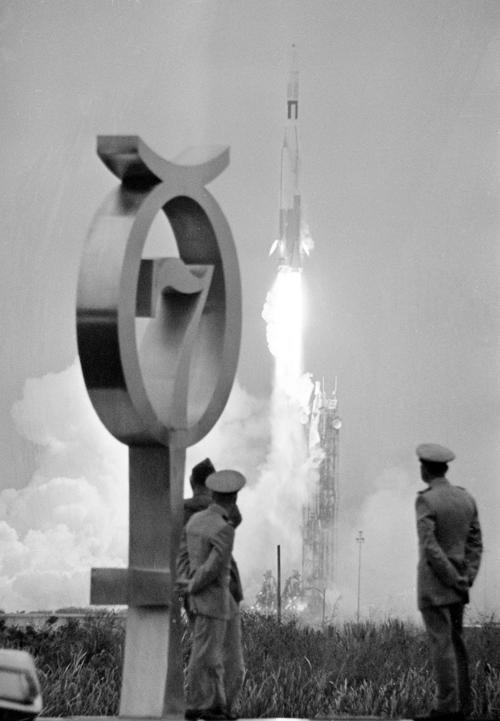
by Kaye Dee
May has been an exciting month for space exploration, with two Soviet space probes arriving at Venus and Apollo-10 safely returning just days ago from its epic lunar voyage, which has constituted a full-dress rehearsal for the first manned Moon landing.  A philatelic cover referring to Apollo-10 as "the Big One before the BIG One"! (Meaning Apollo-11, of course)
A philatelic cover referring to Apollo-10 as "the Big One before the BIG One"! (Meaning Apollo-11, of course)
The Bridesmaid, not the Bride
Before Apollo-10 lifted off on its big mission as NASA’s final test flight ahead of the planned landing of Apollo-11 in July, for a while there was the possibility that the landing attempt might actually be made on this flight, to ensure that American astronauts reached the Moon before any Soviet cosmonauts!  I’m told by my friends at the Honeysuckle Creek Tracking Station, that there was considerable discussion within NASA about accelerating the lunar landing programme. As early as February, even before the launch of Apollo-9, there were suggestions that, if the Earth orbit test of the Lunar Module (LM) was successful, Apollo-10 might go for the first manned lunar landing. George Mueller, Head of NASA’s Office of Manned Space Flight (left), supported this approach. He may not look it, but Dr. Mueller has been described as someone who “always shoots from both hips”, and he strongly pushed for the Apollo-10 landing scenario.
I’m told by my friends at the Honeysuckle Creek Tracking Station, that there was considerable discussion within NASA about accelerating the lunar landing programme. As early as February, even before the launch of Apollo-9, there were suggestions that, if the Earth orbit test of the Lunar Module (LM) was successful, Apollo-10 might go for the first manned lunar landing. George Mueller, Head of NASA’s Office of Manned Space Flight (left), supported this approach. He may not look it, but Dr. Mueller has been described as someone who “always shoots from both hips”, and he strongly pushed for the Apollo-10 landing scenario.
However, a dress rehearsal mission had been planned since June 1967, and the consensus was that the programme was not quite ready to safely achieve a landing with Apollo-10, with more work needed on different docking techniques, as well as more experience with communications and tracking capabilities at lunar distances.
There were concerns that not enough is known about the effect on planned lunar orbit manoeuvres of the Mascons (gravity peaks caused by heavy material under the lunar surface) discovered by Apollo-8. In addition, the lunar landing computer software wasn’t quite ready, and the LM allocated to the Apollo-10 mission was one that had been planned for use in an Earth orbit flight test. Since it was heavier than a LM intended for a lunar landing, its greater weight might have caused problems lifting off the lunar surface. 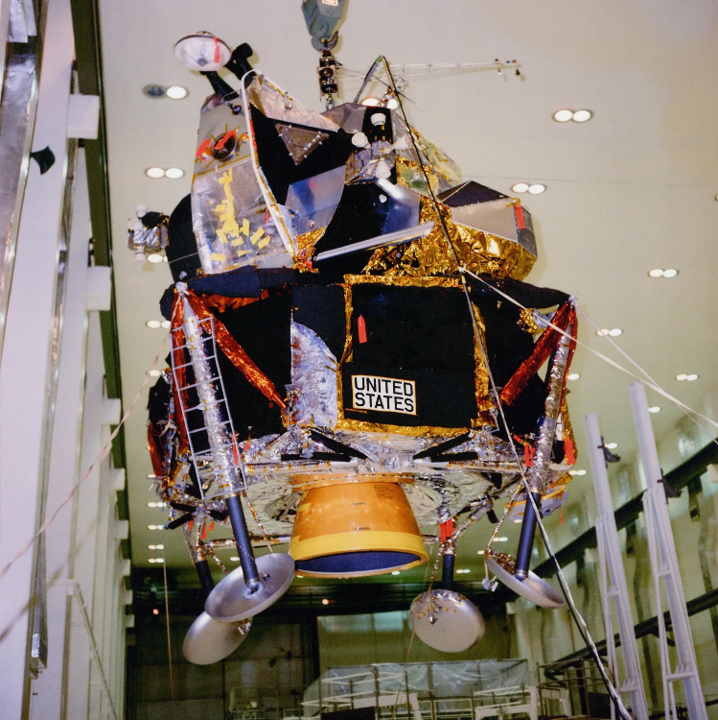 LM-4 being prepared for the Apollo-10 mission at Kennedy Space Centre
LM-4 being prepared for the Apollo-10 mission at Kennedy Space Centre
Thus, on 26 March, with the Saturn-V for its mission already on the launchpad, senior NASA officials finally announced that Apollo-10 would remain the bridesmaid and not become the bride, performing the final full-dress rehearsal for a Moon landing with Apollo-11, rather than itself attempting the historic first lunar touchdown. “With the exception of the actual landing of the Lunar Module on the lunar surface, the mission planned is the same as for the [Apollo-11] lunar mission”, NASA’s announcement of the decision said. 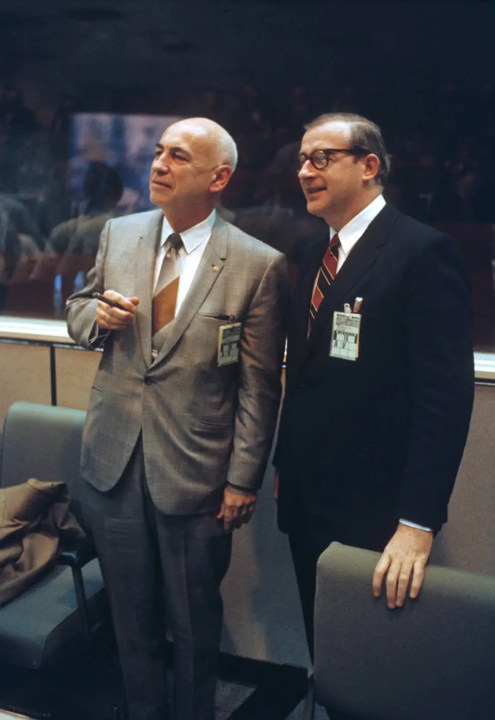 Dr. Paine (right) with Mr. Robert Gilruth, Director of the Manned Spacecraft Centre, celebrating the safe return of Apollo-10
Dr. Paine (right) with Mr. Robert Gilruth, Director of the Manned Spacecraft Centre, celebrating the safe return of Apollo-10
Perhaps Dr. Thomas O. Paine, only confirmed as NASA's third Administrator on 20 March – and a Democrat in the Republican Nixon Administration, which has yet to demonstrate strong enthusiasm for continuing the spaceflight programme of the previous Administration – preferred to err on the side of caution, rather than take another bold gamble like Apollo-8 at such a late stage in the Moon landing programme.
Seasoned Crew
Whether Apollo-10 remained the lunar landing dress rehearsal, or if it had become the first mission to land on the Moon, its crew were well-qualified for either mission scenario, as seasoned veterans of Gemini spaceflights.  Mission Commander Colonel Thomas Stafford previously flew as Pilot of the Gemini-VI mission, and then as Commander of Gemini-IX. On the latter flight, his Pilot was Commander Eugene “Gene” Cernan, assigned as LM Pilot for Apollo-10. The third member of the Apollo-10 crew, Command Module (CM) Pilot Commander John Young, made his first spaceflight as Pilot of Gemini-III, before becoming Commander of Gemini-X. I think NASA would have been hard-pressed to assemble a more experienced crew for this crucial flight.
Mission Commander Colonel Thomas Stafford previously flew as Pilot of the Gemini-VI mission, and then as Commander of Gemini-IX. On the latter flight, his Pilot was Commander Eugene “Gene” Cernan, assigned as LM Pilot for Apollo-10. The third member of the Apollo-10 crew, Command Module (CM) Pilot Commander John Young, made his first spaceflight as Pilot of Gemini-III, before becoming Commander of Gemini-X. I think NASA would have been hard-pressed to assemble a more experienced crew for this crucial flight.
A Mission Patch with Mission Heritage
North American Rockwell artist Allen Stevens, who has previously collaborated with the crews to design the mission patches for Apollo-1 , 7, and 9, apparently wanted to break away from the circular shape used for so many previous missions. He initially offered the Apollo-10 crew some concepts based on polygonal patch shapes, but these did not appeal. 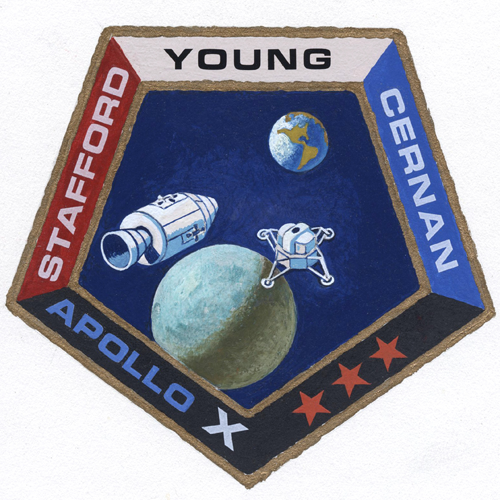
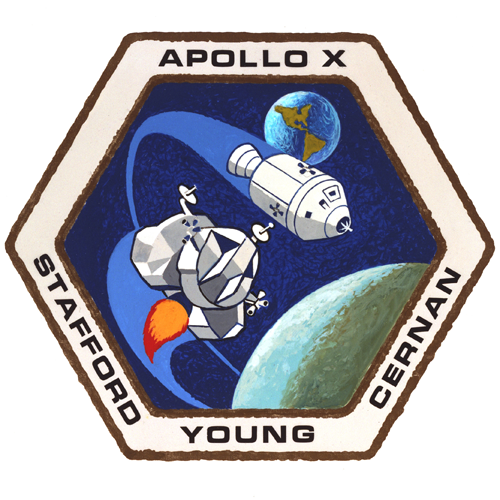 Instead, US Navy officers Cernan and Young primarily developed the patch, which Stevens then illustrated. Their concept drew heavily on the design of Stafford and Cernan’s Gemini-IX mission patch, especially using the shape of a shield.
Instead, US Navy officers Cernan and Young primarily developed the patch, which Stevens then illustrated. Their concept drew heavily on the design of Stafford and Cernan’s Gemini-IX mission patch, especially using the shape of a shield. 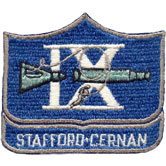
Astronaut Cernan has said that the mission patch was based on the mechanics and goals of the mission, and this is exemplified in the dominance of the spacecraft and the mission number represented by a large Roman numeral in the middle of the design.  The final version of the Apollo-10 patch depicts the CM circling the Moon as the LM makes its low pass over the surface, with the Earth in the background. The three-dimensional rendering of the Roman ‘X’ gives the impression that it is sitting on the Moon, its prominence in the illustration indicating the mission’s significance in furthering the Apollo programme. The crew names appear around the rim of the shield.
The final version of the Apollo-10 patch depicts the CM circling the Moon as the LM makes its low pass over the surface, with the Earth in the background. The three-dimensional rendering of the Roman ‘X’ gives the impression that it is sitting on the Moon, its prominence in the illustration indicating the mission’s significance in furthering the Apollo programme. The crew names appear around the rim of the shield.
A Mascot Namesake
With two spacecraft operating independently around the Moon, the CM and LM would need their own individual callsigns, as was the case with Apollo-9. For their historic mission, the Apollo-10 crew looked to the popular “Peanuts” comic strip, injecting a light-hearted note into a critical mission by designating the Command Module “Charlie Brown” and the Lunar Module “Snoopy”. It seems that NASA executives were once again unhappy with the crew’s choice of names, being particularly concerned about the perception of the hapless Charlie Brown as a born loser. 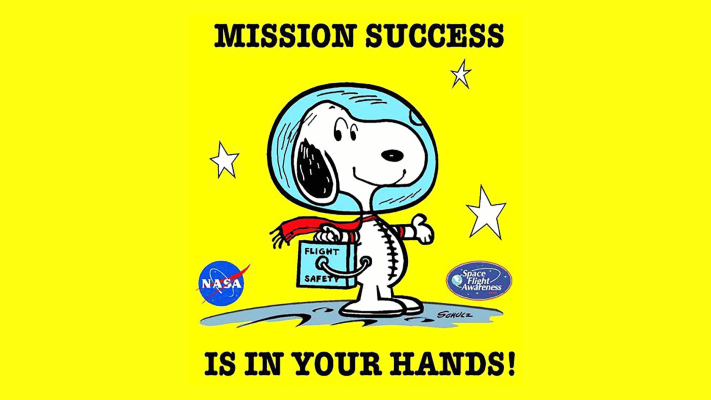 But the two characters, particularly Snoopy, have been associated with spaceflight since last year, when the lovable beagle was adopted as the mascot for NASA’s Manned Spaceflight Awareness programme. This safety campaign, begun in 1963, focuses on encouraging the workforce constructing spacecraft and equipment for NASA to remember that astronaut lives, and mission success, depend upon the quality and reliability of their work: a message that has taken on new meaning and urgency following the Apollo-1 fire. Snoopy, with his daring imaginary adventures (as a World War 1 flying ace, Olympic skater and other action roles), seemed an ideal choice for a mascot to raise morale and increase visibility for the renewed effort.
But the two characters, particularly Snoopy, have been associated with spaceflight since last year, when the lovable beagle was adopted as the mascot for NASA’s Manned Spaceflight Awareness programme. This safety campaign, begun in 1963, focuses on encouraging the workforce constructing spacecraft and equipment for NASA to remember that astronaut lives, and mission success, depend upon the quality and reliability of their work: a message that has taken on new meaning and urgency following the Apollo-1 fire. Snoopy, with his daring imaginary adventures (as a World War 1 flying ace, Olympic skater and other action roles), seemed an ideal choice for a mascot to raise morale and increase visibility for the renewed effort.
In 1968, with the permission and participation of “Peanuts” creator Charles Schultz, Snoopy became not only the mascot for this programme, but the symbol of its special achievement award, the “Silver Snoopy”. The award recognises individuals within the NASA workforce and contractors who have made valuable contributions to safety and mission assurance. Recipients receive a silver lapel pin which depicts a spacesuited Snoopy doing his famous “happy dance”.  A batch of Silver Snoopy pins was carried to the Moon on Apollo-8, and each award pin is presented to its recipient by an astronaut. As a person can only be honoured once with a Silver Snoopy award, it has already become a highly-coveted form of recognition.
A batch of Silver Snoopy pins was carried to the Moon on Apollo-8, and each award pin is presented to its recipient by an astronaut. As a person can only be honoured once with a Silver Snoopy award, it has already become a highly-coveted form of recognition.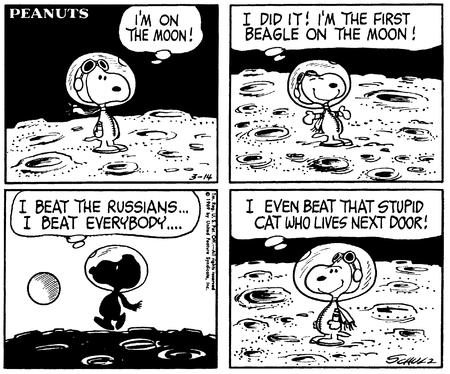 Snoopy-ing Around
Snoopy-ing Around
In March this year, Snoopy beat the Apollo-11 crew to a Moon landing in his comic strip fantasies, but he and Charlie Brown are turning up in many guises across the space agency, frequently featuring on motivational posters. 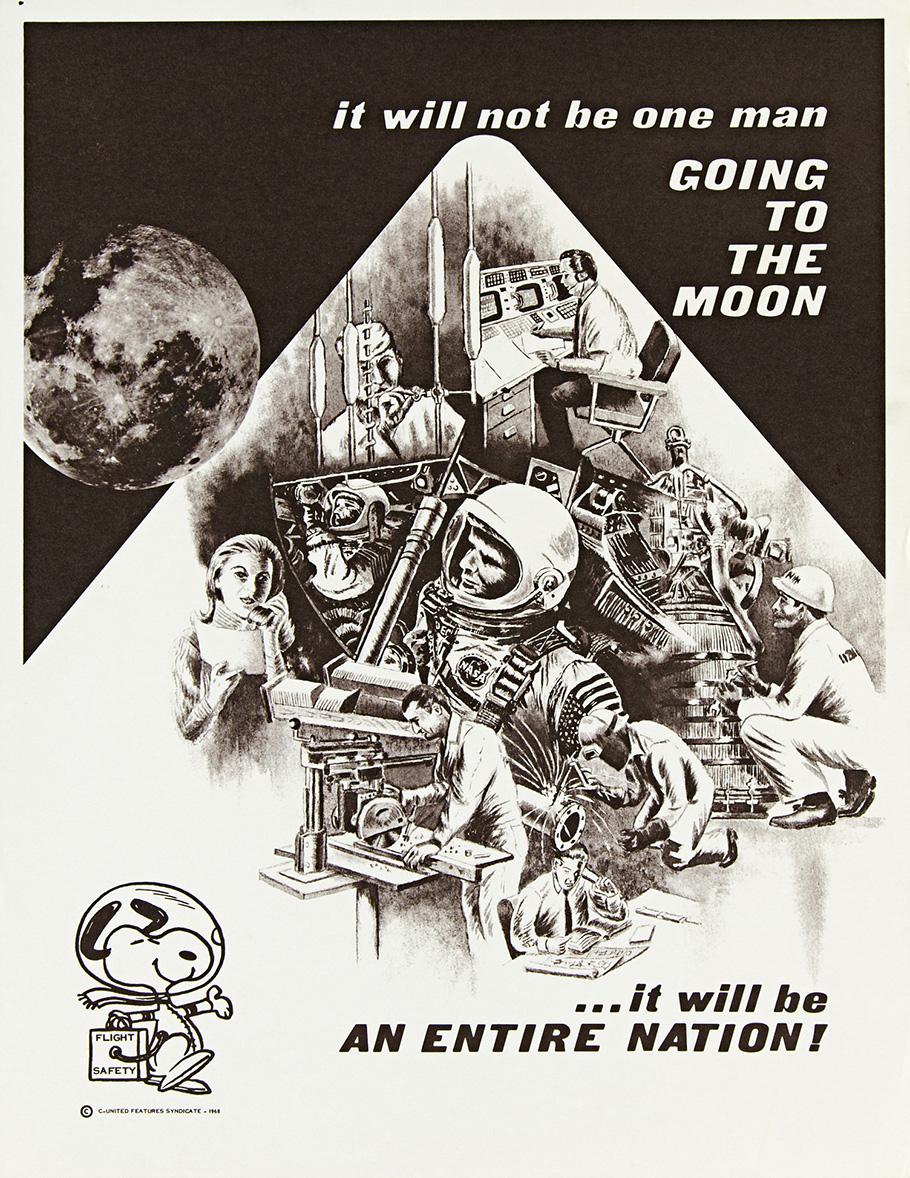
 Small models of the boy and his dauntless dog are found in the Apollo spacecraft simulator area, where the astronauts spend much of their time in training. The astronauts have also taken to calling their communications headgear “Snoopy caps”, because of their resemblance to the flying helmet Snoopy wears in his daydreams of battling the Red Baron. The black-and-white design of the caps also recalls Snoopy's white head and black ears. Toy models of Charlie Brown and astronaut Snoopy also graced the consoles in Mission Control while Apollo-10 was in flight.
Small models of the boy and his dauntless dog are found in the Apollo spacecraft simulator area, where the astronauts spend much of their time in training. The astronauts have also taken to calling their communications headgear “Snoopy caps”, because of their resemblance to the flying helmet Snoopy wears in his daydreams of battling the Red Baron. The black-and-white design of the caps also recalls Snoopy's white head and black ears. Toy models of Charlie Brown and astronaut Snoopy also graced the consoles in Mission Control while Apollo-10 was in flight.  In an interview in April, Col. Stafford explained why the astronauts adopted the Snoopy and Charlie Brown callsigns. “Since we're going to the Moon to find all these facts and kind of snoop around, we decided that the Lunar Module is going to be called Snoopy. Snoopy is a comic character that’s a favourite, I know, of many people in the United States and around the world, and to go with it, we'll call the Command Module Charlie Brown”. In the same interview Commander Cernan also referenced the Silver Snoopy as a reason for the name choice, saying “Snoopy is a sort of champion of the space programme, anyway”.
In an interview in April, Col. Stafford explained why the astronauts adopted the Snoopy and Charlie Brown callsigns. “Since we're going to the Moon to find all these facts and kind of snoop around, we decided that the Lunar Module is going to be called Snoopy. Snoopy is a comic character that’s a favourite, I know, of many people in the United States and around the world, and to go with it, we'll call the Command Module Charlie Brown”. In the same interview Commander Cernan also referenced the Silver Snoopy as a reason for the name choice, saying “Snoopy is a sort of champion of the space programme, anyway”. 
Getting Ready
Despite not landing on the Moon, Apollo-10 was still going to be a big mission, with its flight plan closely following that of Apollo-11. To enable detailed photography of the designated Apollo-11 landing site at the Sun angle planned for the July mission, the launch was postponed from 16 to 17 May. In March, it was delayed again to 18 May, to allow for a better view of the backup landing site. An extra day in lunar orbit was also added to the mission to provide time for additional testing of the LM’s systems and photography of possible future Apollo landing sites. 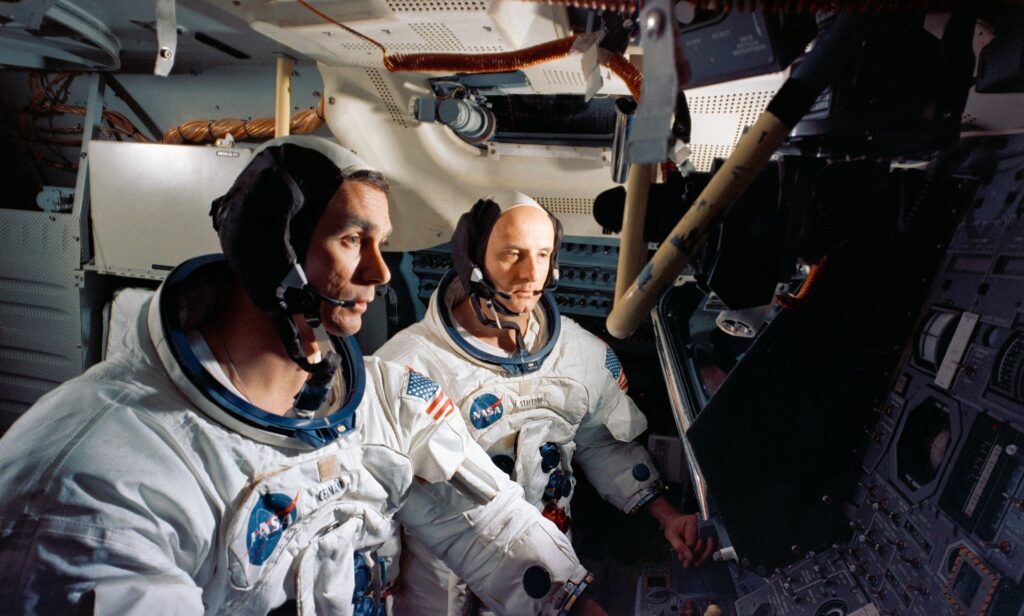 Col. Stafford and Commander Cernan training for their flight in the LM simulator
Col. Stafford and Commander Cernan training for their flight in the LM simulator
The Apollo-10 crew’s intensive mission training schedule saw them putting in five hours of formal training for every hour of their mission’s eight-day duration. This included more than 300 hours each in the CM or LM simulators, and centrifuge training to prepare for the high-acceleration conditions they would endure during re-entry.
An accidental fuel spillage from the first stage of the Saturn V at the end of April fortunately caused no damage, and countdown preparations went ahead as planned, with no major delays. On 14 May, the astronauts received their final lunar topography briefing from scientist-astronaut, geologist Dr. Harrison Schmidt, and were pronounced fit and ready for lunar flight in their final medical checks. Everything was ready for the full-dress rehearsal of a manned lunar landing! 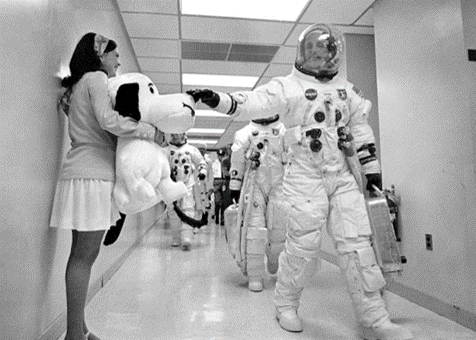 Mission Commander Stafford pats a giant Snoopy plush toy for luck, as the crew walk out to the Astronaut Transfer Van. Snoopy is being held by Cernan's secretary, Jamye Flowers
Mission Commander Stafford pats a giant Snoopy plush toy for luck, as the crew walk out to the Astronaut Transfer Van. Snoopy is being held by Cernan's secretary, Jamye Flowers
Lift Off!
Due to mission scheduling requirements, Apollo-10 was slated to lift off from Launch Complex 39B at Kennedy Space Centre, the first Apollo mission to use that pad. (LC 39A, used for Apollo-8 and 9 is being used for Apollo-11, whose Saturn V vehicle was rolled out to the pad just a few days before the Apollo-10 launch). Firing Room 3, at Kennedy Space Centre’s Launch Control Centre was also used for the first time on Apollo-10’s launch.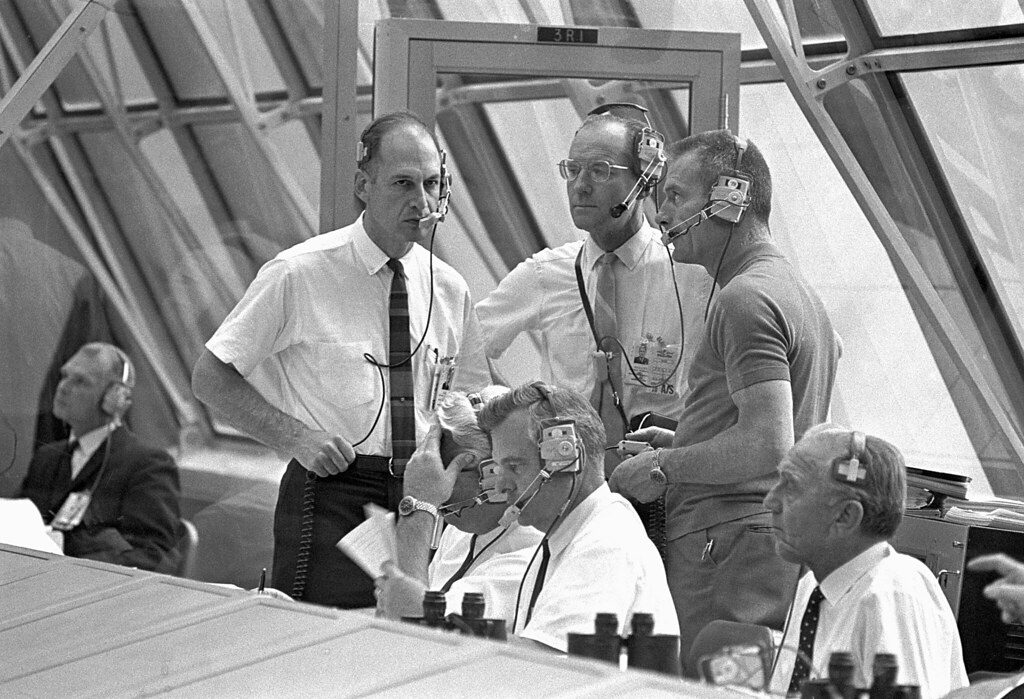 Mission Director of Flight Crew Operations Deke Slayton and other NASA officials in Firing Room-3 during Apollo 10's pre-flight preparations
Mission Director of Flight Crew Operations Deke Slayton and other NASA officials in Firing Room-3 during Apollo 10's pre-flight preparations
Apollo-10 lifted off exactly on time at 16.49 GMT on 18 May. Although pogo effects gave the astronauts something of a rough ride into orbit, this fortunately had no impact on the mission. However, during Trans-Lunar Injection (TLI) burn, shuddering vibrations caused by the S-IVB stage pressure relief valves blurred the astronauts’ vision, to the point that they feared that the mission might have to be aborted. Fortunately, after five minutes the burn ended satisfactorily, with Apollo-10 safely on the way to the Moon.
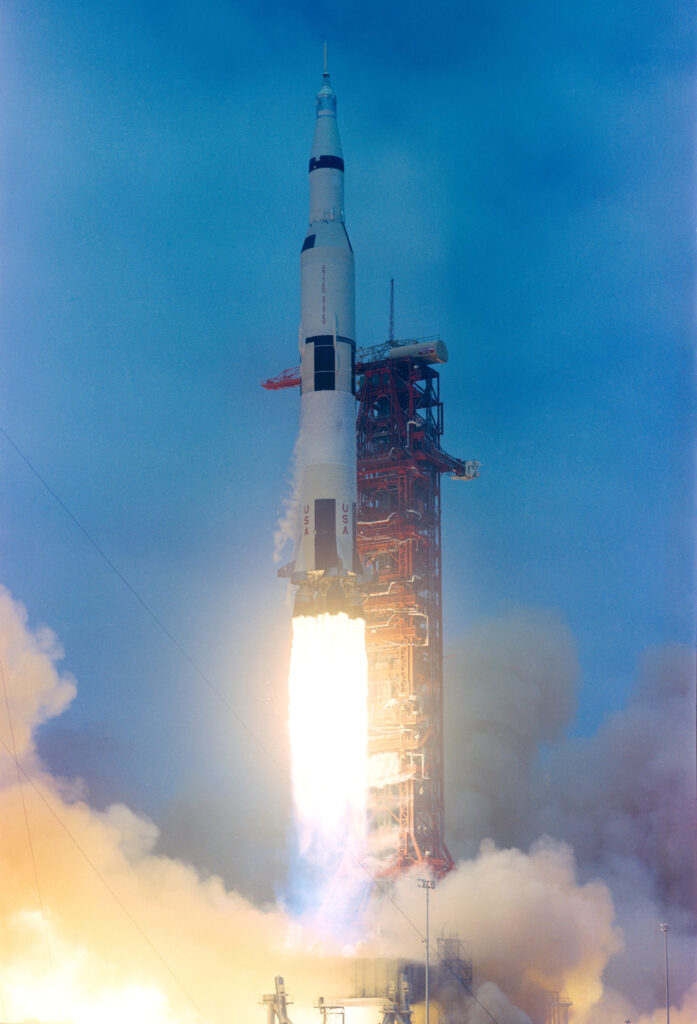
The TLI burn occurred about 100 miles above outback Queensland, witnessed on the ground by thousands of people thanks to perfect observing conditions. A local official in the town of Cloncurry gave an interview to NBC News, which I understand was broadcast live in the US, describing what they saw: “The veil surrounding the relatively large white spot of the rocket’s rear end could best be described as resembling a mercury vapor street light seen through thick fog, although it was of a tenuous nature.” I've not yet seen a picture of the Apollo TLI burn from Queensland, but this photo of the Apollo-8 TLI burn above Hawaii will give some idea of the amazing sight seen by many in remote Queensland towns
I've not yet seen a picture of the Apollo TLI burn from Queensland, but this photo of the Apollo-8 TLI burn above Hawaii will give some idea of the amazing sight seen by many in remote Queensland towns
Coming to You in Living Colour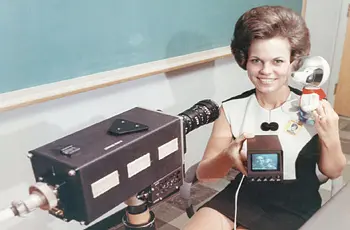 The Apollo-10 Westinghouse colour television camera and its custom-made viewing monitor for onboard use in the CM
The Apollo-10 Westinghouse colour television camera and its custom-made viewing monitor for onboard use in the CM
Apollo 10 has seen the first use of a compact colour television camera, developed by Westinghouse. Installed in the CM, the camera was first used to show mission controllers in Houston the complex transposition, docking, and extraction manoeuvre performed by CM Pilot John Young, to extract the LM from the S-IVB stage, attaching it to the nose of the Command Module for the journey to the Moon. 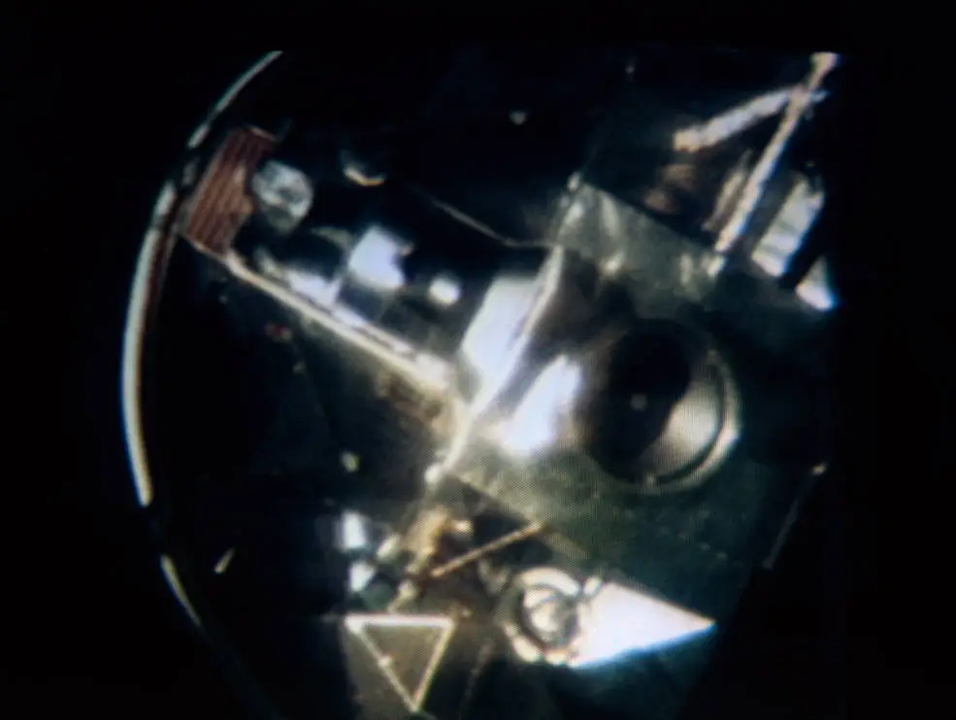 Soon after the special LM extraction transmission, the first public broadcast on the way to the Moon treated the audience to live colour vistas of the Earth from 25,000 miles away in a thirteen-minute show.
Soon after the special LM extraction transmission, the first public broadcast on the way to the Moon treated the audience to live colour vistas of the Earth from 25,000 miles away in a thirteen-minute show. 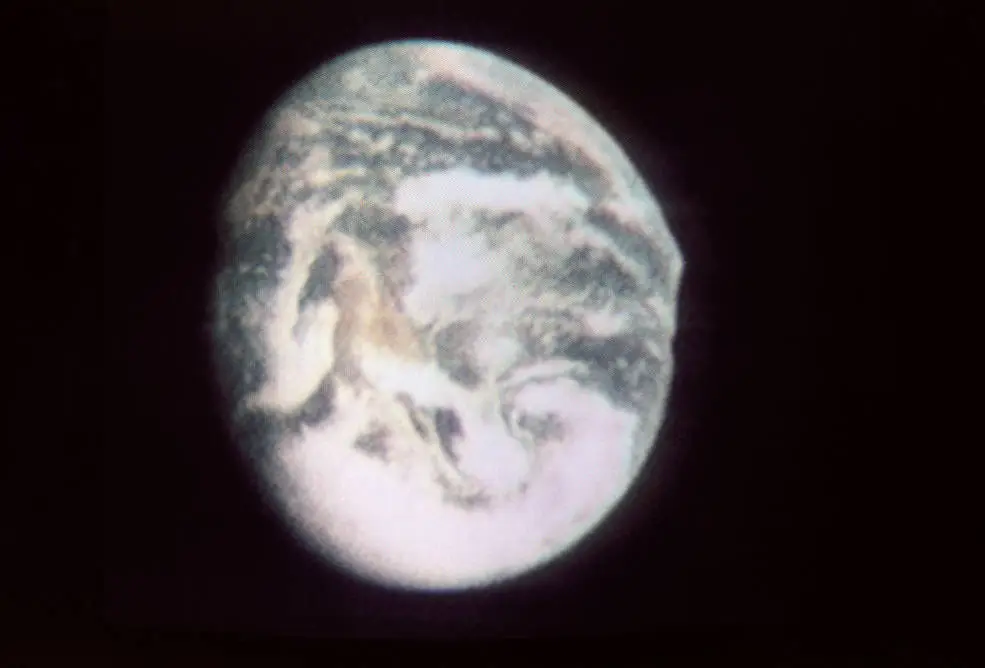
This was followed, before the crew's first sleep period, with a 24-minute TV transmission, that began with views from 36,300 nautical miles in space, showing the Earth floating in the black void of the cosmos. The scene moved LM Pilot Cernan to say: "It's just sitting out there in the middle of nowhere. It's unbelievable…it's just incredible".
The camera was then turned inside the the CM showing the astronauts themselves. Capcom Bruce McCandless commented, “It’s really great. The colours are fantastic.”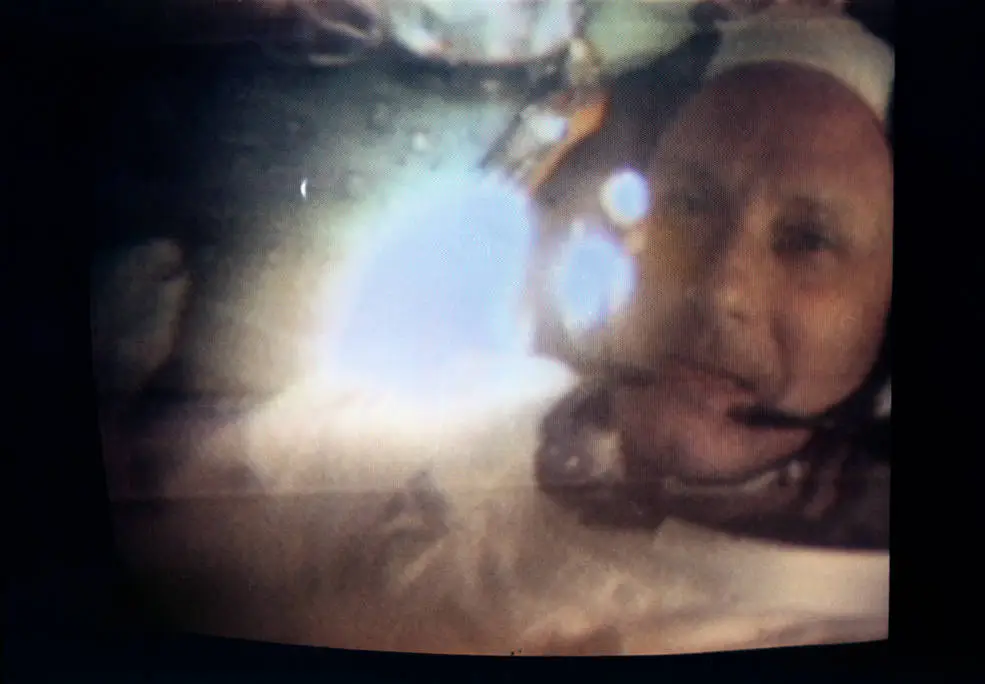
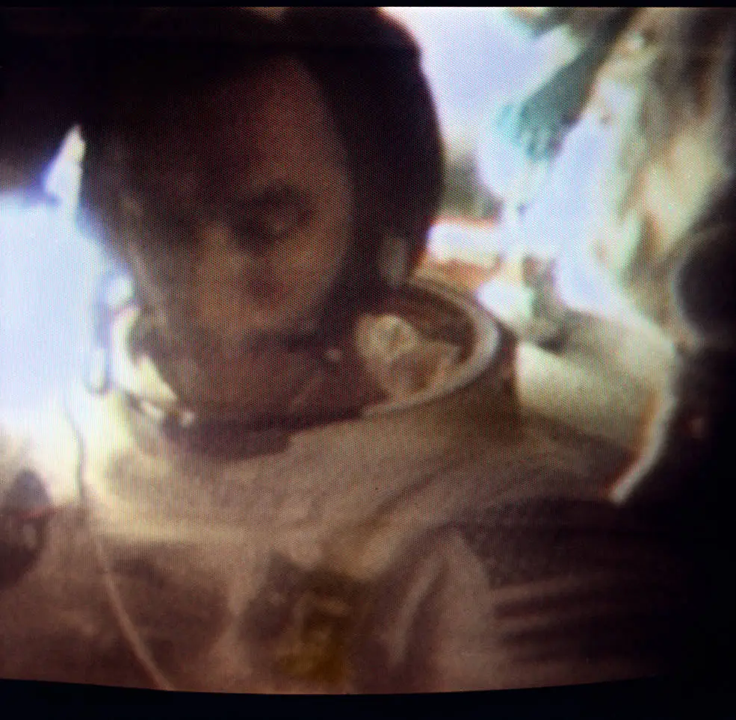
 Images of the Apollo-10 crew captured during one of the broadcasts from the CM. Stafford (top), Cernan (middle), Young (bottom)
Images of the Apollo-10 crew captured during one of the broadcasts from the CM. Stafford (top), Cernan (middle), Young (bottom)
The Apollo-10 crew must have thought their colour camera was a great new toy, as they treated Earth audiences to nineteen colour television transmissions, totalling 5 hours 52 minutes across the entire mission. In one of the early broadcasts, the crew displayed colour illustrations of Charlie Brown and Snoopy, produced by a NASA illustrator, which I understand were intended as colour calibration checks. 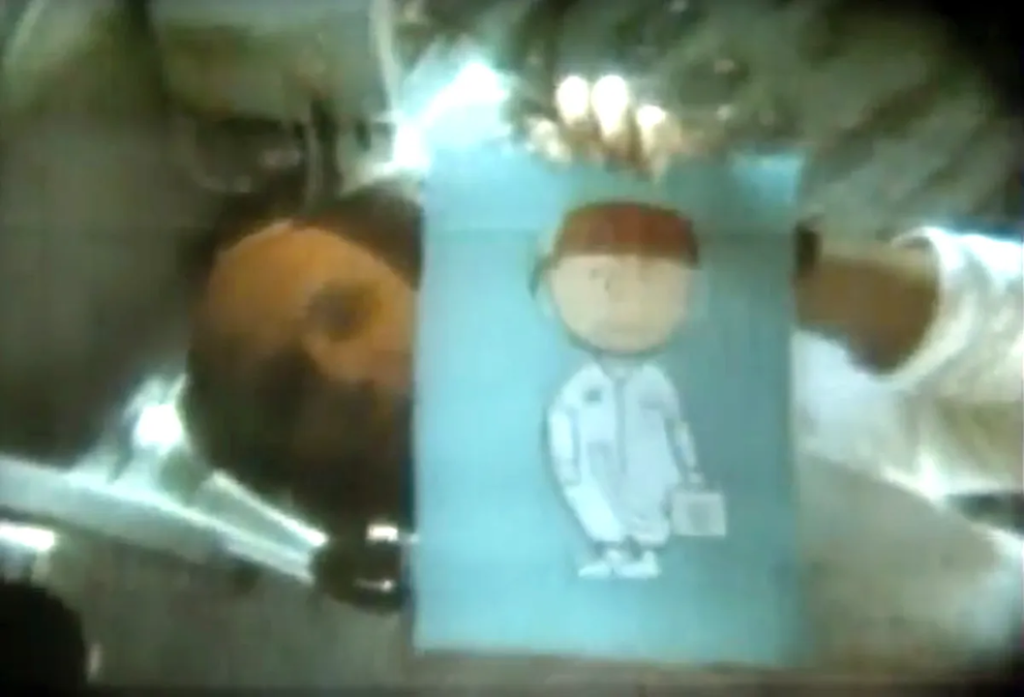

During another broadcast on the way to the Moon, Astronauts Stafford and Young were shown side by side, with Young upside down to demonstrate the weightless environment. Col. Stafford, using just a light touch, moved his CM pilot up and down, as Young joked “I do everything he tells me.”
 Monitors in Mission Control show the Stafford-Young broadcast from the CM demonstrating the weightless environment
Monitors in Mission Control show the Stafford-Young broadcast from the CM demonstrating the weightless environment
The first broadcast after Trans-Earth Injection was initially received in Australia and distributed to the local television networks (albeit in black and white, since we don't yet have colour television), prior to transmission back to the United States and on to the rest of the world. This functioned as a test for the systems that have been put in place to handle Australia's potential role as the prime receiver for Apollo-11's lunar surface transmissions.
Amusingly, the normally laconic Cernan and Stafford gushed like schoolboys on an outing, clearly excited to be floating in weightlessness, on their way to the Moon. Speaking of which, it was just shortly before this flight that NASA determined what was causing some astronauts to get "space sick" during missions. It wasn't a cold or food-related; it was weightlessness, itself, affecting the inner ear adversely.
Eating Out
Food for the astronauts is being continually improved, and new items were added to the menu on this mission, such as small sandwiches with real bread, and ham, chicken and tuna salad. I've heard that this expanded menu was a real boost to the crew's morale as they travelled to the Moon – although looking at pictures of some space foods, I'm not so sure that they are appetising, even if they are nutritious. 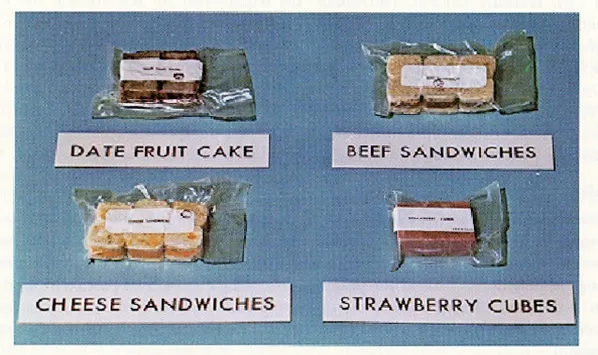
(above) Some of the new menu items available to the Apollo-10 crew. (below) I'm not so sure about the new dehydrated chicken salad! 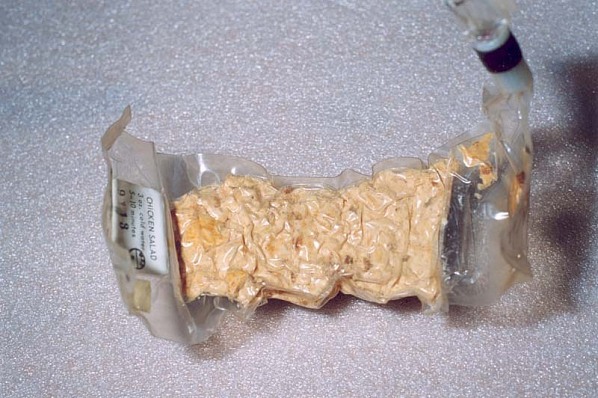
Another innovation for Apollo-10 has been the introduction of the "wet pack" or "spoon bowl" packaging, allowing the astronauts to eat many meals with a spoon! To reduce the risk of food floating away and becoming a nuisance and potential hazard to electronic equipment, the spoon-eatable wet pack food is mixed with just enough water to make it sticky, so that it clings to the inside of the container and sticks on the spoon. (above) A spoon-bowl container with a beef and vegetable meal. It looks a lot more enjoyable to eat than that chicken salad
(above) A spoon-bowl container with a beef and vegetable meal. It looks a lot more enjoyable to eat than that chicken salad
Unfortunately, some food on Apollo-10 was not so morale-boosting, as Col. Stafford apparently put too much chlorine in the drinking water used to rehydrate the meals, making the dehydrated foods taste strange.
Cruising Along
The astronauts had a relatively light workload on the way to the Moon, with only one slight course correction to place Apollo-10 on the trajectory Apollo-11 is expected to take. The only real problem they encountered was that the mylar cover of the CM’s hatch pulled loose, spreading shreds of fibreglass insulation into the docking tunnel, CM and LM. 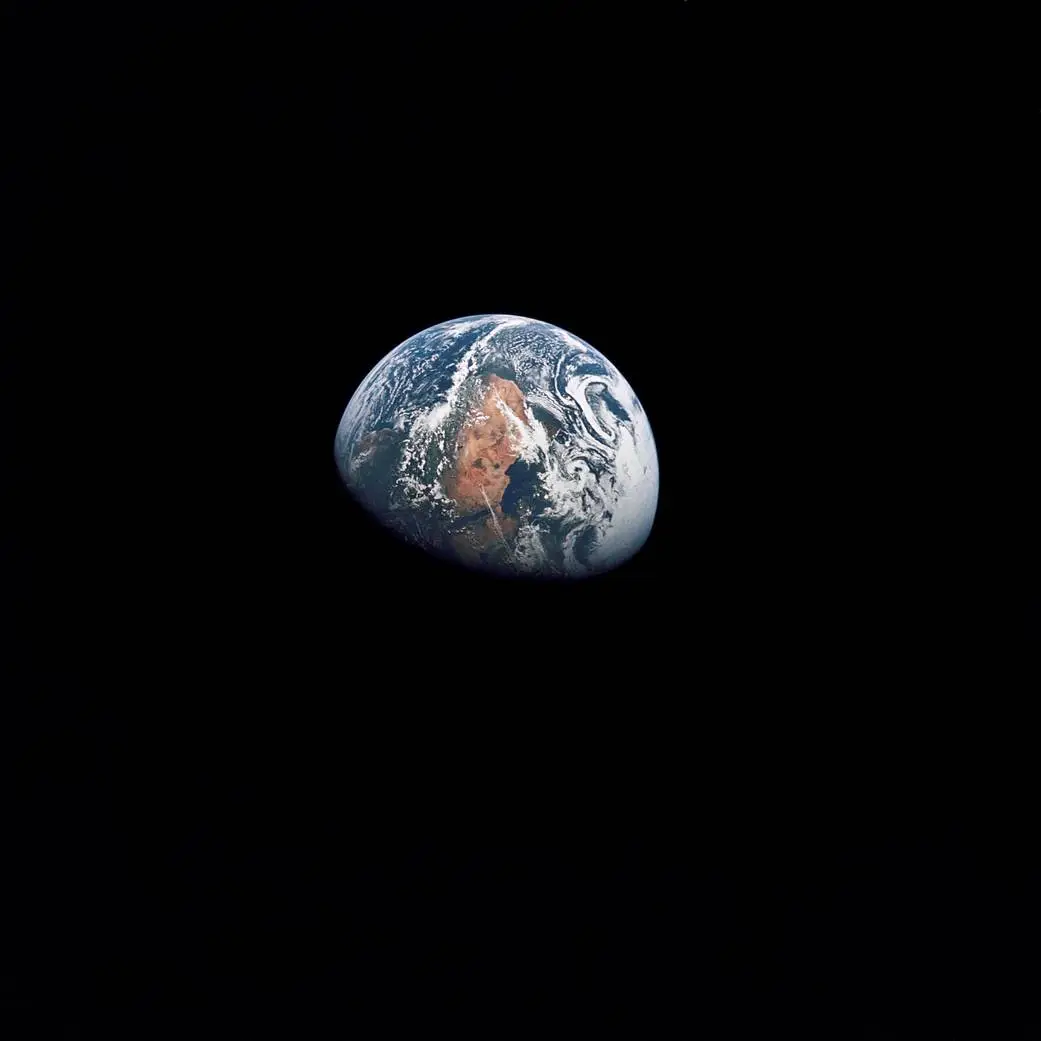 Photograph of the Earth from 100,000 miles, showing parts of Africa, Europe and the Middle East
Photograph of the Earth from 100,000 miles, showing parts of Africa, Europe and the Middle East
About 62 hours after launch, Apollo-10 crossed into the Moon’s gravitational sphere of influence, passing about 10 hours later into the darkness of the lunar shadow. Just on 76 hours into the mission, Apollo-10 passed behind the Moon, with the Lunar Orbit Insertion burn occurring out of radio contact with the Earth. Fortunately, this manoeuvre experienced no issues and Apollo-10, now safely in lunar orbit, emerged from the behind the Moon to begin the real work of the mission. “You can tell the world that we have arrived,” Col. Stafford announced. The Real Work Begins
The Real Work Begins
Almost as soon as they were back in contact with the Earth, the crew began describing the lunar terrain they were flying over, with Commander Cernan saying, “It might sound corny, but the view is really out of this world.” Within the first couple of hours at the Moon, after circularising their orbit at approximately 60 nautical miles above the Moon, the crew began planned observations of lunar surface landmarks. This included photographing three of the proposed Apollo-11 landing sites (which the astronauts would also photograph at a lower altitude from LM Snoopy), as well as many craters and other surface features. 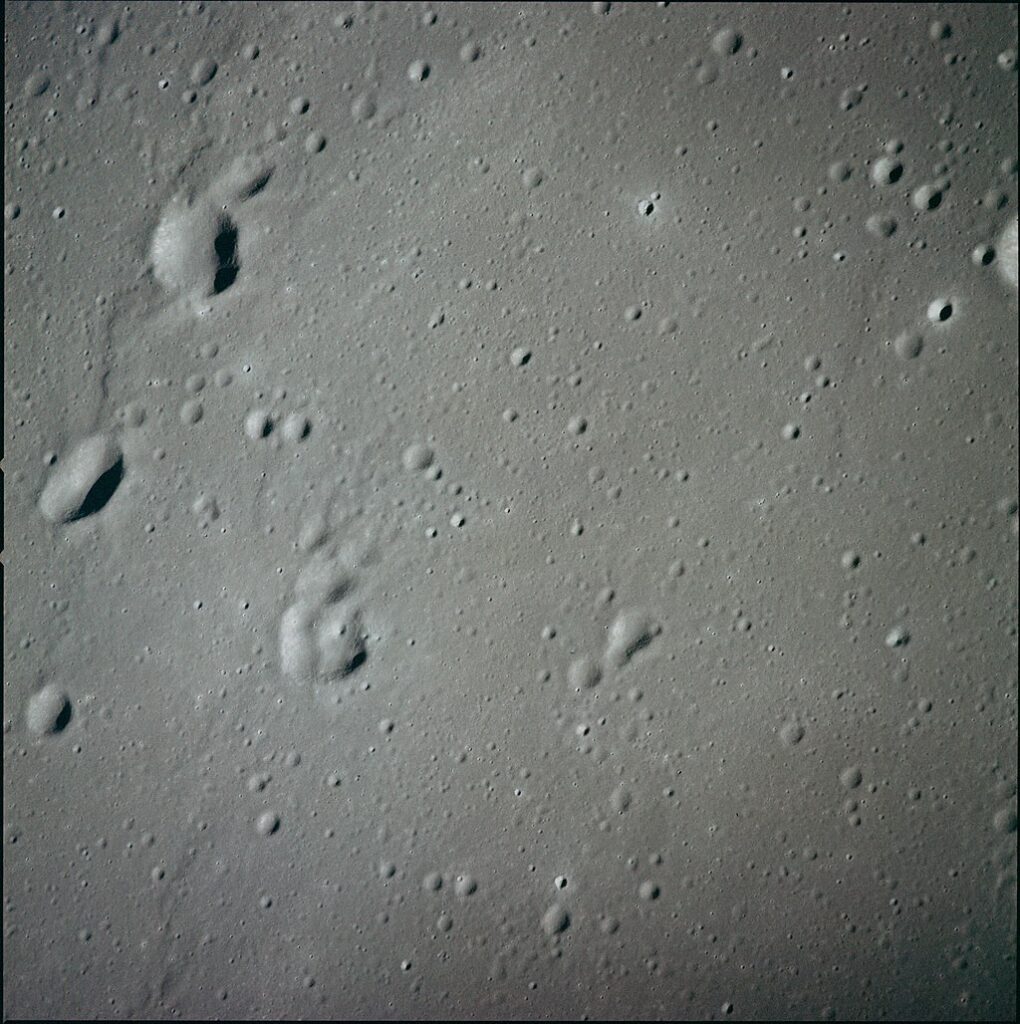
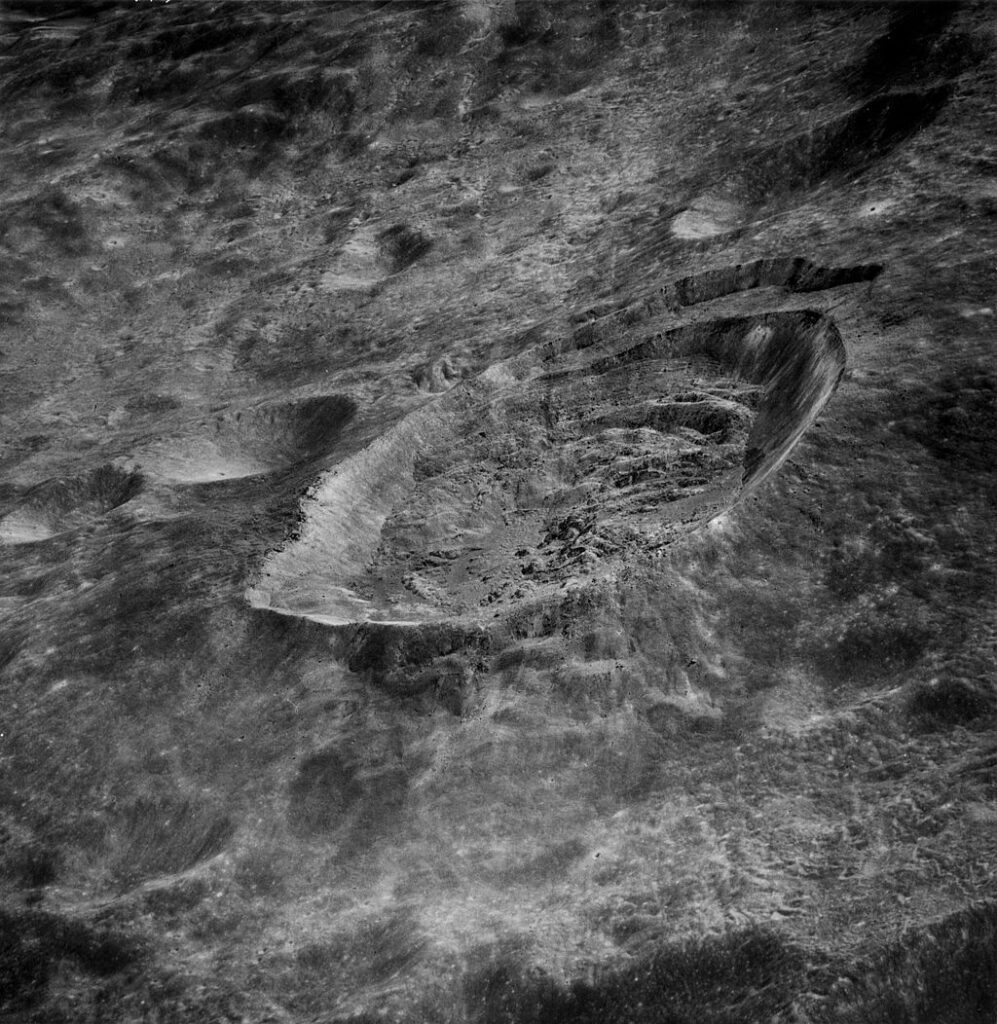 (top) A view of the prime Apollo-11 landing site. (bottom) Crater Necho on the far side of the Moon
(top) A view of the prime Apollo-11 landing site. (bottom) Crater Necho on the far side of the Moon
For their first telecast from lunar orbit, the Apollo-10 crew described the lunar terrain speeding below them, which included the approach to the Apollo-11 landing site in the Sea of Tranquillity. I could only see this broadcast in black and white, but I understand that for viewers in the US and other parts of the world, the colour and quality of the television images was quite breathtaking: these stills made available to me by the Australian NASA representative certainly suggest that! 
 (top) Colour view of craters Messier and Messier-A (bottom) Crater Maskelyne
(top) Colour view of craters Messier and Messier-A (bottom) Crater Maskelyne
Waking Up Snoopy
When Commander Cernan opened Snoopy’s hatch for the first time, to be engulfed in fibreglass particles from the earlier damage to the CM hatch, bits got into his hair and eyebrows. Col. Stafford helped remove some of these particles, remarking that the LM Pilot “looked like he just came out of a chicken coop”. Though the astronauts used a vacuum cleaner to remove as much of the fibreglass particles as possible, tiny flecks annoyingly continued to circulate in the spacecraft, making the astronauts itch. They got into the air conditioning system and had to be constantly scraped from the CM’s filter screens for the rest of the mission.
Despite the fibreglass nuisance, Cernan partially activated the LM, conducted communications checks, and prepared the vehicle for its test flight. “I’m personally very happy with the fellow”, the LM Pilot later reported to Mission Control, saying in reference to the next day’s flight “We’ll take him out for a walk and let him stretch his legs in the morning.”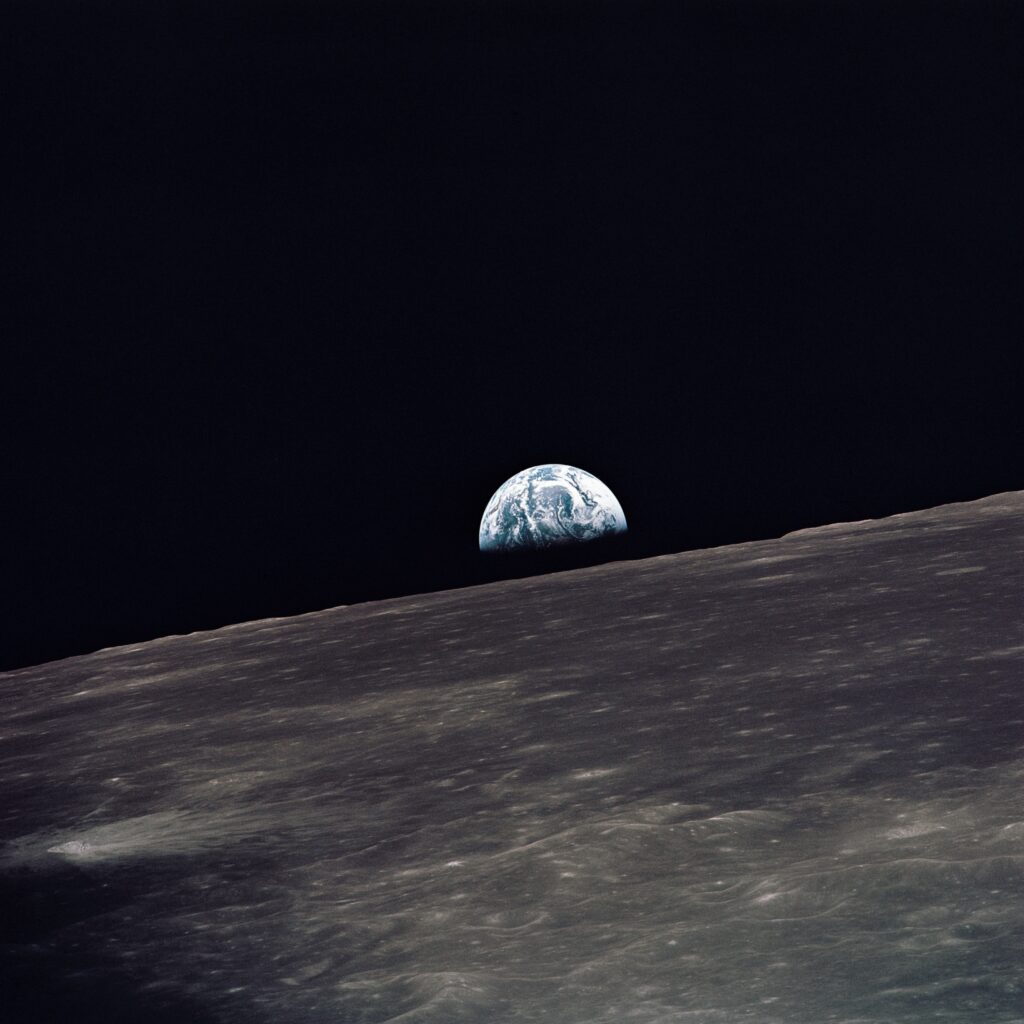 A spectacular Earthrise image captured during Apollo-10's first orbit of the Moon
A spectacular Earthrise image captured during Apollo-10's first orbit of the Moon
Taking Snoopy for a Walk
Apollo-10’s first full day in lunar orbit was going to be its busiest, with the critical eight-hour sequence of manoeuvres in lunar orbit to simulate all aspects of Apollo-11 mission operations except the landing itself. Stafford and Cernan transferred to Snoopy, while Young remained in Charlie Brown. Despite some issues with the docking tunnel, Mission Control assured the astronauts that it was safe to undock, and the two craft separated while they were out of contact behind the Moon. 
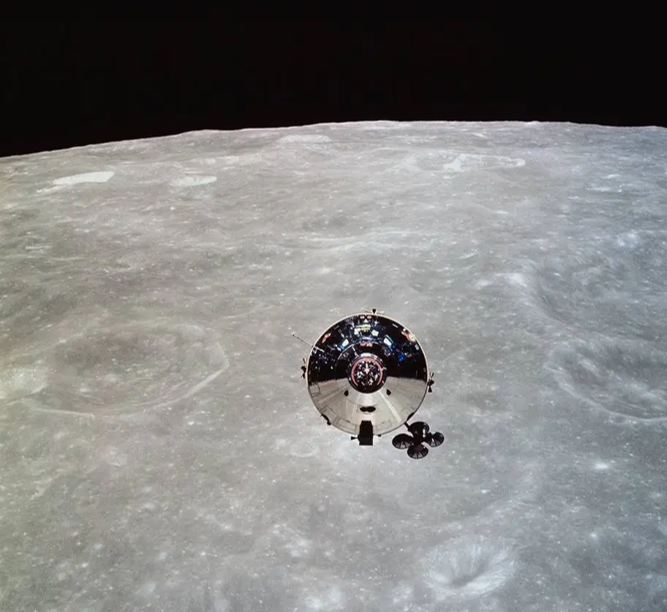 Returning to contact with Earth, Commander Young made a visual inspection of the LM and then fired the CM’s thrusters to separate from Snoopy. With a GO from Mission Control, Snoopy commenced its Descent Orbit Insertion burn while on the lunar farside, to lower itself to about 50,000 feet. This critical manoeuvre took place behind the Moon, so that the low point of its orbit would be reached on the nearside near the Apollo-11 landing area in the Sea of Tranquillity. As they looped back around to the nearside of the Moon, Cernan reported to Capcom Charles Duke, “We is down among them, Charlie,” referring to their low altitude over the lunar landscape.
Returning to contact with Earth, Commander Young made a visual inspection of the LM and then fired the CM’s thrusters to separate from Snoopy. With a GO from Mission Control, Snoopy commenced its Descent Orbit Insertion burn while on the lunar farside, to lower itself to about 50,000 feet. This critical manoeuvre took place behind the Moon, so that the low point of its orbit would be reached on the nearside near the Apollo-11 landing area in the Sea of Tranquillity. As they looped back around to the nearside of the Moon, Cernan reported to Capcom Charles Duke, “We is down among them, Charlie,” referring to their low altitude over the lunar landscape. 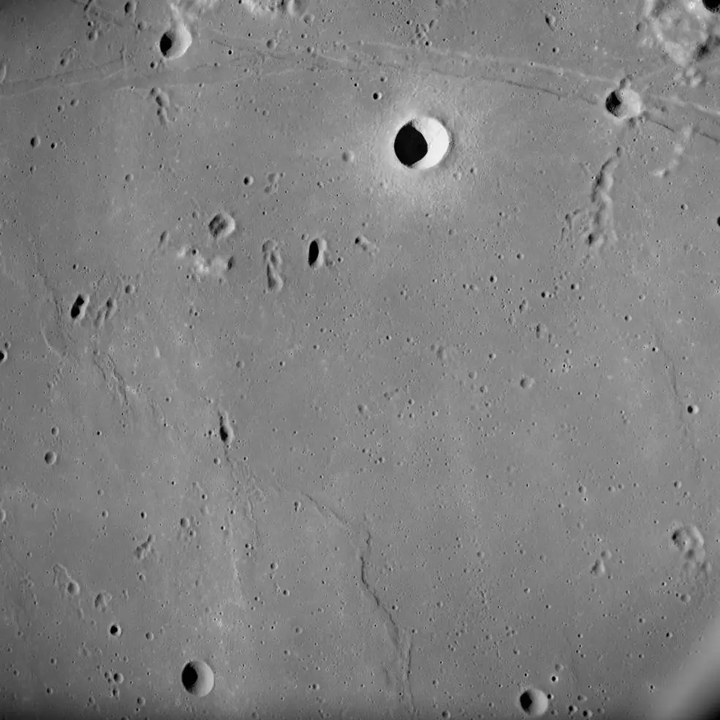 A low-altitude view of the Apollo-11 prime landing site, focussed towards the upper right of the image
A low-altitude view of the Apollo-11 prime landing site, focussed towards the upper right of the image
Snoopy successfully tested the landing radar, a particularly critical test in advance of the actual landing mission, as the crew maintained a running commentary describing the landscape below them, including all the landmarks leading up to the planned Apollo 11 landing site. This was followed by a firing of the LM’s Descent Propulsion System to set up the right orbital geometry for a simulated liftoff from the Moon during the next orbit.
Crisis averted
As Snoopy’s crew prepared to separate the LM’s ascent stage from the lower stage, the vehicle began to gyrate and tumble out of control, causing Cernan to utter a shocked expletive that was broadcast live, bringing some complaints about his language (though I think his outburst was perfectly understandable in the circumstances).
Col. Stafford quickly discarded the descent stage and fought to manually regain control of the LM, suspecting a thruster stuck firing. Fortunately, after about eight seconds Snoopy was brought back under control and the Ascent Stage, was able to safely climb to orbit, mimicking the orbital insertion manoeuvre after launch from the lunar surface that Apollo-11 would have to conduct.
For a tense hour, it looked as if the Apollo-11 mission was in jeopardy. If the ascent stage always subjected its crew to "wild gyrations" upon firing, that was a problem that had to be solved, and pronto. Fortunately, the actual cause of the problem was determined quickly: it seems that a switch controlling the mode of the abort guidance system, a sort of back-up computer, has been left on, conflicting with the main guidance computer. That issue is easily resolved with a better checklist!
Blue Moon
There are rumours that NASA deliberately did not load Snoopy with enough propellant to safely land on the Moon and return to orbit, in order to dissuade Stafford and Cernan from unofficially attempting the first lunar landing. However, I’m told that, since Snoopy was overall too heavy to attempt a safe return from the lunar surface, the ascent stage was loaded with the equivalent quantity of propellant that it would have had remaining if it had lifted off from the lunar surface and reached the altitude at which the Apollo-10 ascent stage was fired. 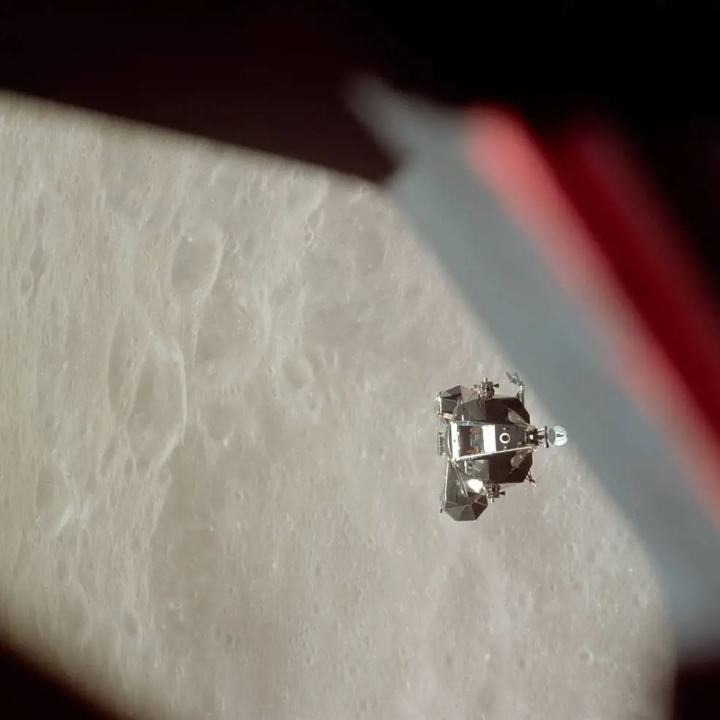 After coasting for about an hour, Snoopy performed manoeuvres to bring it close to Charlie Brown, while the two craft were behind the Moon. Just after they returned to contact with the Earth, Commander Young completed the CM-LM docking, with Stafford joking that “Snoopy and Charlie Brown are hugging each other.” During its independent flight of 8 hours 10 minutes, Snoopy met all planned objectives for the Lunar Module flight tests.
After coasting for about an hour, Snoopy performed manoeuvres to bring it close to Charlie Brown, while the two craft were behind the Moon. Just after they returned to contact with the Earth, Commander Young completed the CM-LM docking, with Stafford joking that “Snoopy and Charlie Brown are hugging each other.” During its independent flight of 8 hours 10 minutes, Snoopy met all planned objectives for the Lunar Module flight tests.  The scene in Mission Control as the LM and CM are safely docked together
The scene in Mission Control as the LM and CM are safely docked together
With all the astronauts safely back in the CM, Snoopy was cut free from Charlie Brown. To prevent any further contact between the two spacecraft, Snoopy’s ascent engine was automatically fired to fuel depletion, sending it safely out of lunar orbit and into an orbit around the Sun. LM Pilot Cernan said sadly, “I feel sort of bad about that, because he’s a pretty nice guy; he treated us pretty well today.”
On Their Way Home
During their final day in lunar orbit, the Apollo-10 crew took stereo images of the Apollo-11 landing site, gave another 24-minute colour TV broadcast, and prepared the spacecraft for its critical Trans Earth Injection manoeuvre, that would send the CM out of lunar orbit and on its way back to Earth. Just as with Apollo-8, this critical engine firing occurred while the spacecraft was behind the Moon and out of radio communications with Earth.
With extra fuel left over from the lunar activities, Apollo-10 burnt it off to accelerate the spacecraft back to Earth, the return trajectory taking only 42 hours rather than the normal 56. By the time it reached re-entry, the CM was travelling at 24,791 mph relative to Earth on re-entry, making the crew of Apollo 10 the fastest humans in history!
During their relatively lazy return to Earth, the Apollo-10 astronauts indulged themselves with the first shave in space. Using safety razors, a thick shaving gel and a wet cloth to wipe away gel and whiskers, the crew displayed freshly shaven visages during their final broadcast from space.  Eight days after launch (with a mission elapsed time of 192:03:23), Apollo-10 splashed down safely in the Pacific Ocean on 26 May, about 400 nautical miles east of American Samoa and just a couple of miles from the recovery ship USS Princeton. The carrier crew witnessed the spectacular sight of the Service Module streaking across the pre-dawn sky in a blazing fireball as it burned up, followed by the Command Module silhouetted against the brightening sky under its three big parachutes.
Eight days after launch (with a mission elapsed time of 192:03:23), Apollo-10 splashed down safely in the Pacific Ocean on 26 May, about 400 nautical miles east of American Samoa and just a couple of miles from the recovery ship USS Princeton. The carrier crew witnessed the spectacular sight of the Service Module streaking across the pre-dawn sky in a blazing fireball as it burned up, followed by the Command Module silhouetted against the brightening sky under its three big parachutes.  When the astronauts, waiting in their “rubber-ducky” to be retrieved, looked up at the recovery helicopter hovering above they saw “Hello there Charlie Brown” written across the underside of the fuselage!
When the astronauts, waiting in their “rubber-ducky” to be retrieved, looked up at the recovery helicopter hovering above they saw “Hello there Charlie Brown” written across the underside of the fuselage! 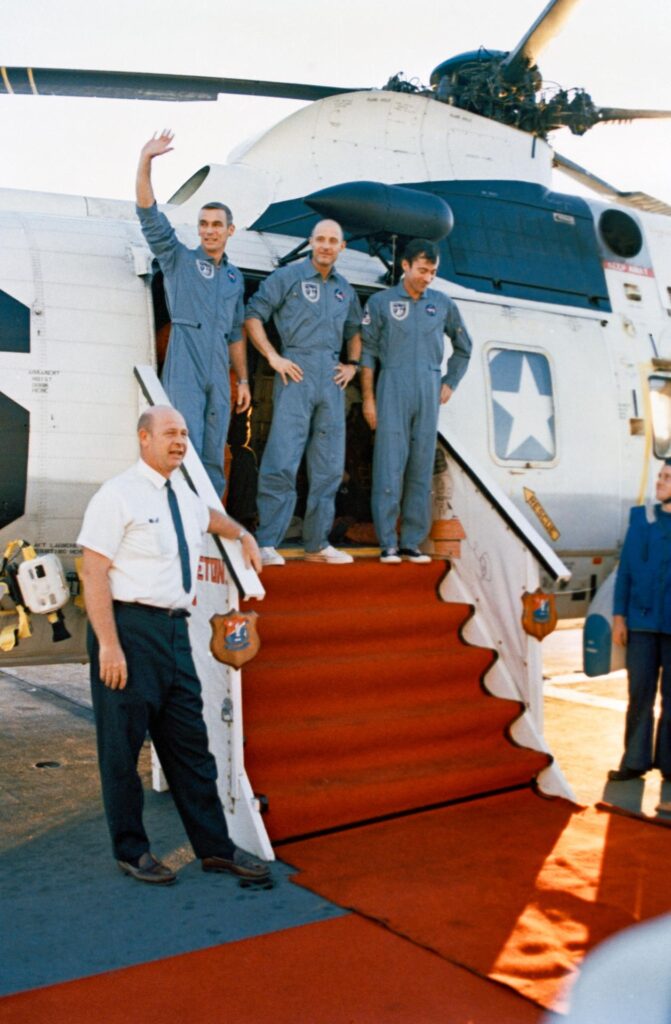 After taking a congratulatory phone call from President Richard Nixon, the crew were flown to Pago Pago and then on to Ellington Air Force Base near Houston, where they are now undergoing medical checks, debriefing and, of course, re-union with their families.
After taking a congratulatory phone call from President Richard Nixon, the crew were flown to Pago Pago and then on to Ellington Air Force Base near Houston, where they are now undergoing medical checks, debriefing and, of course, re-union with their families.
Apollo-10 has completed an epic voyage that has in many ways surpassed even Apollo-8. Its completion of a successful full-dress rehearsal, means that nothing now stands in the way of the first manned landing taking place in July 1969, with Apollo-11 – that will be the BIG one, to stand on the shoulders of this big test-flight mission. I can't wait! 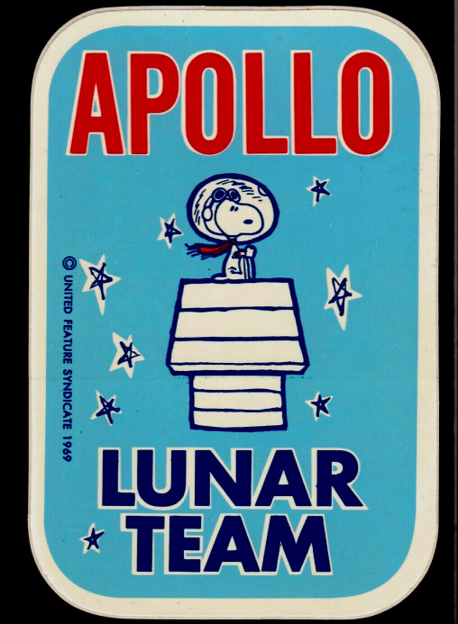

![[May 28, 1969], The Big One Before the Big One (Apollo-10)](https://galacticjourney.org/wp-content/uploads/2024/05/Apollo-10-Snoopy-ascent-stage-672x372.png)

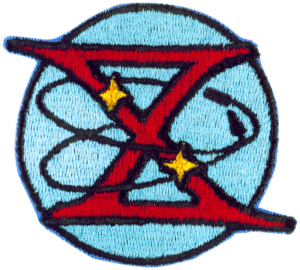
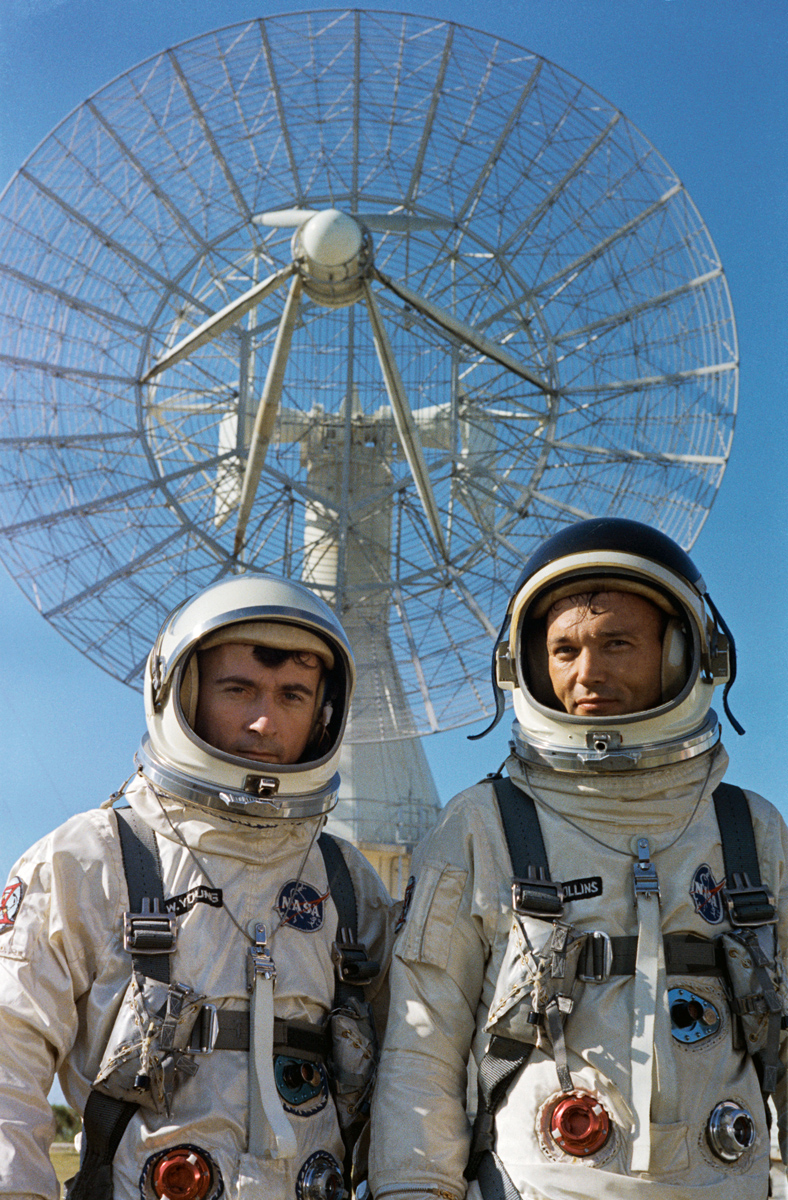
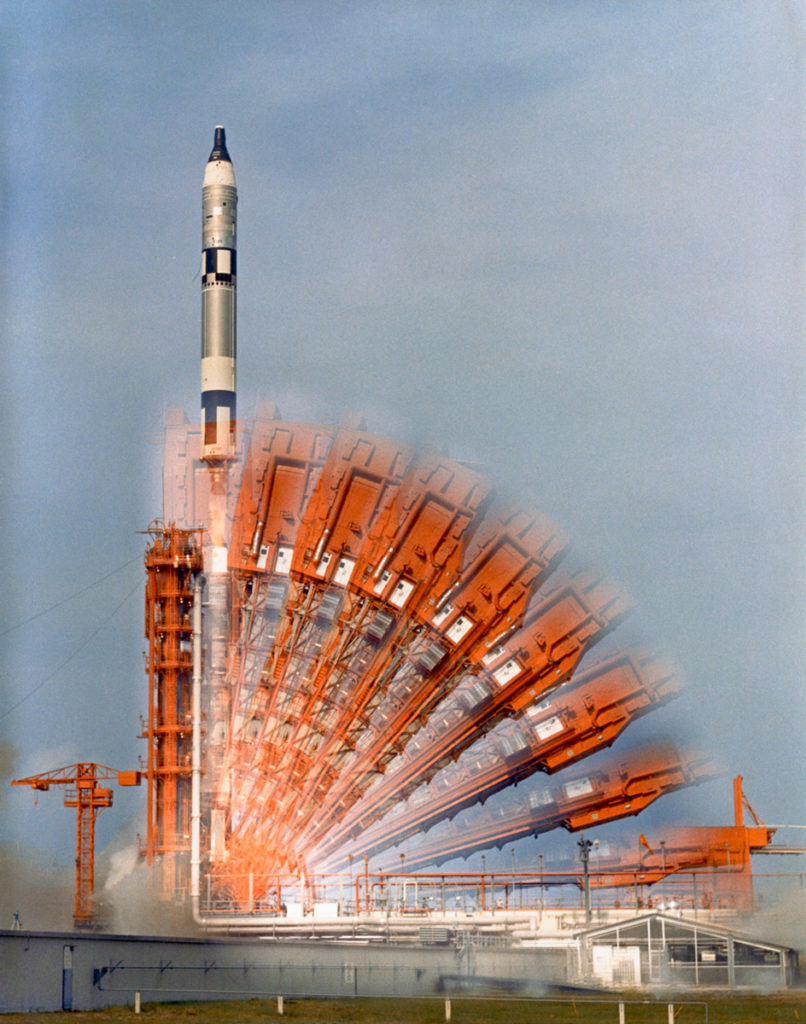

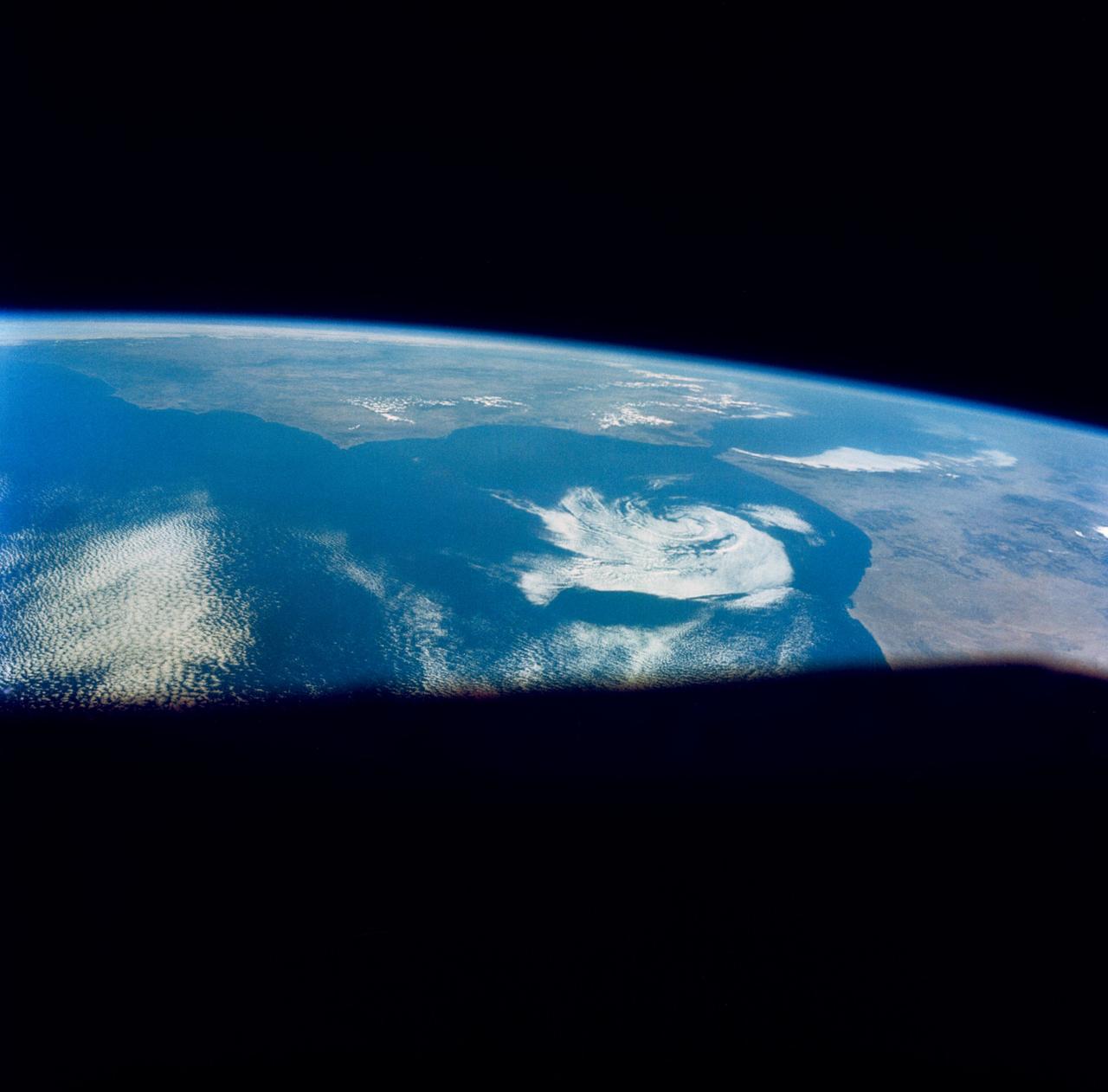

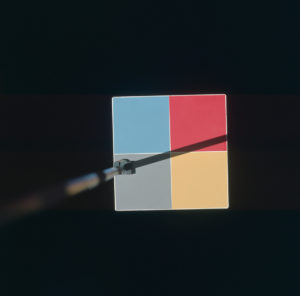
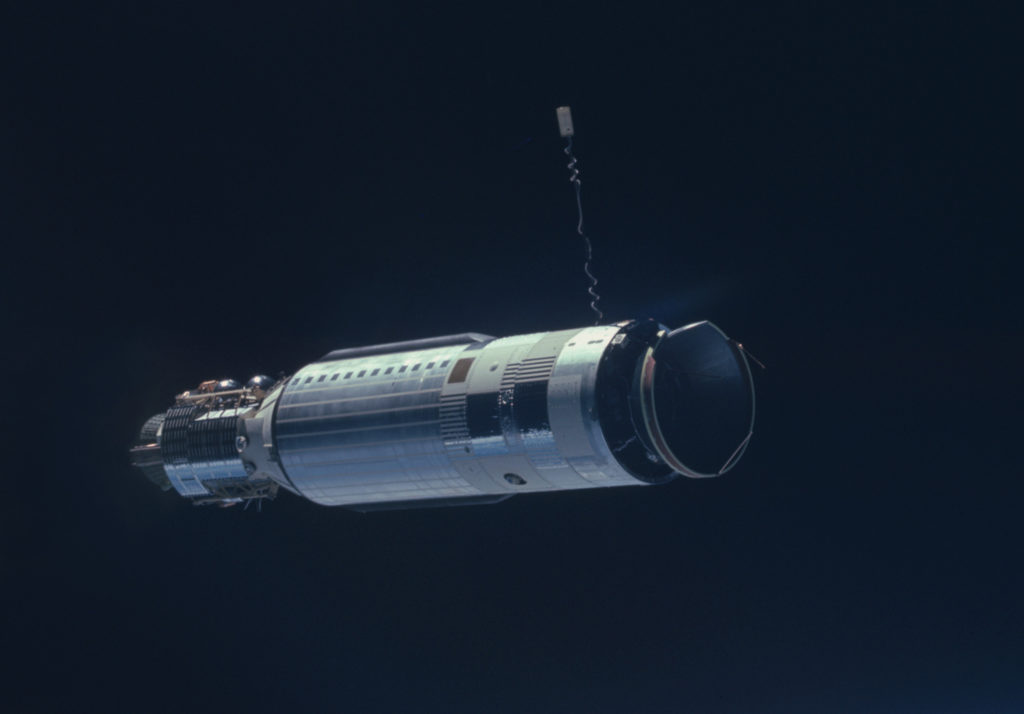
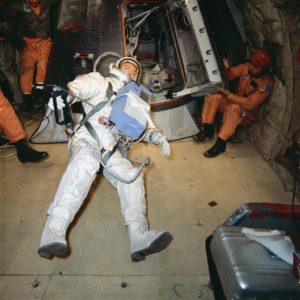
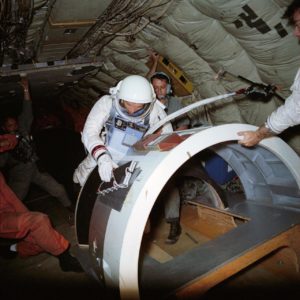


![[March 24, 1965] New Leaps Forward in Space (Voskhod 2, Europa F-3, Ranger 9, and Gemini 3)](https://galacticjourney.org/wp-content/uploads/2020/03/Voskhod-spacewalk-397x372.jpg)









